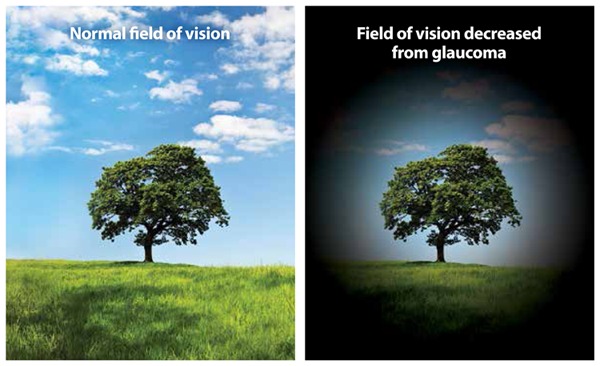

Earlier this week, in light of Glaucoma Awareness being observed this month, Our Today provided you with the signs symptoms and treatment of the disease. In continuing to acknowledge its observance, the focus will be on the causes, risk factors and types of glaucoma.
Causes

In the back of your eye, there is a continuous clear fluid being made called the the aqueous humor. While the fluid is being made, it fills the front part of the eye and exits the eye through channels of the cornea and iris.
If by chance these channels are somehow blocked or obstructed, then this can increase the natural pressure in the eye known as intracranial pressure (IOP). As the pressure increases, damage may be done to your optic nerve. As the damage to the nerve progresses, this may cause you to lose your sight.
Although the cause of the increase in pressure to the eye is not always known, doctors do believe one or more of the following factors contribute the issue:
- high or elevated blood pressure
- medications
- dilating eye drops
- poor or reduced blood flow to optic nerve
- blocked or restricted drainage in your eye
- eye surgery in some cases
- severe eye infection
Risk Factors

There are several risk factors that can increase one’s chances of suffering from the disease. These include:
Age – People that are over 60 stand at a higher chance of contracting glaucoma. Africans, however, are at an increased risk by age 40. Developing the disease increases slightly with each year of the age.
Race – Africans, Asians and Native Alaskans stand at a greater chance at developing glaucoma. Those of Asian descent and Native Alaskans are at higher risk of developing angle-closure glaucoma. While people of Japanese descent are more likely to develop low-tension glaucoma.
Medical Condition – There have been studies which posit that having diabetes, high blood pressure, and heart disease may increase one’s risk of contracting the eye condition.
Medication – Utilising corticosteroids (a class of steroids) for prolonged periods of time can increase one’s risk of developing glaucoma.
Family History – As many of us know, a family having history of any disease makes one more susceptible to contracting it. With a family history of glaucoma, there is the increased likelihood of developing it.
Injuries to the eye – Physical injury or trauma to the eye (such as being hit in the eye) can cause immediate eye pressure. Internal injuries from the trauma can cause future increased pressure. Thin corneas or chronic eye inflammation can also lead to build up in pressure.
Other eye-related risk factors – Retinal detachment, eye tumors and being extremely nearsighted or farsighted can trigger glaucoma.
Types

The types of glaucoma include:
- Primary open-angle Glaucoma – this shows no signs or symptoms except gradual vision loss. This is said to be the most common type of glaucoma.
- Angle-closure Glaucoma – this is usually an emergency situation. If you experience symptoms such as nausea, severe pain and blurred vision, call your doctor immediately.
- Secondary Glaucoma – this is often a side effect of another eye condition such as cataract or an eye tumor. Corticosteroids medication may also lead to secondary glaucoma and in very rare cases, surgery.
- Normal-tension or low-tension glaucoma – if there is no damage caused by eye pressure development, the cause of this type of glaucoma is usually unknown. However, lack of blood flow to the optic nerve or extreme sensitivity may lead to this type of glaucoma.
- Congenital Glaucoma or Childhood Glaucoma – usually occurs in babies and young children. Children born with this type of glaucoma have a defect in the angle of their eye that can slow or prevent fluid drainage. Running in the family, congenital glaucoma usually presents symptoms such as usually cloudy eyes, excessive tearing, or sensitivity to light.







Comments